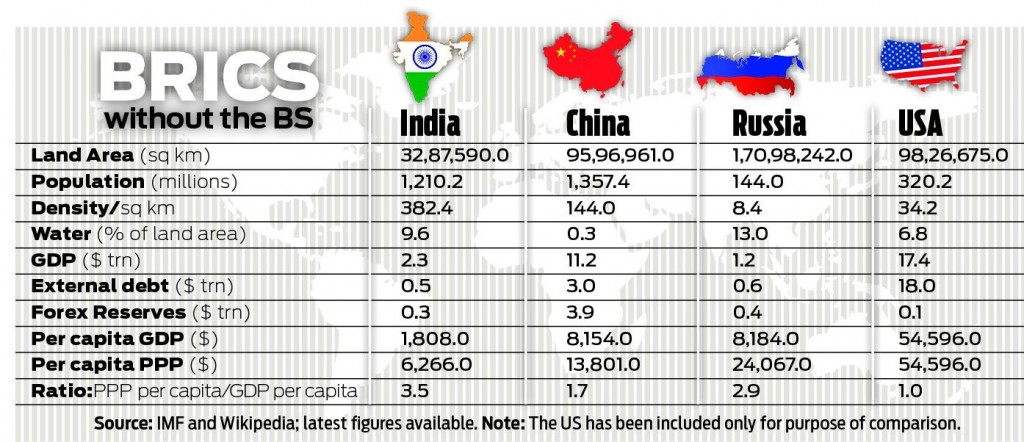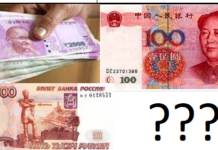https://www.dnaindia.com/analysis/column-policy-watch-can-modi-and-xi-reshape-eurasia-2082715
R N Bhaskar
4 May 2015
Within a fortnight, Prime Minister Modi will embark on his visit to China. Most analysts expect this visit to be momentous. Both Modi and China president Xi Jinping have critical issues on their mind which can easily be addressed by each other.
For Modi, the burning issue is unemployment and infrastructure development. He has to create employment opportunities for some 350 mllion people within a decade.
China has the world’s largest reserves of foreign exchange – see table – and can easily finance this. In fact, China is only too willing to play the role of developer and financier for projects in India.
For China, India represents a market, which could easily be the world’s largest. It needs such a market desperately because it is experiencing an economic slowdown. Slowdowns can be terrible because they mean layoffs. That spells unemployment. China cannot afford to keep the unemployed in the cities (it does not want slums, and concentrated pockets of insurrection). Nor can it afford to send the unemployed back to the villages, because they could spread discontent there. Large-scale unrest in vast rural areas is a recipe for political instability. For China, the West is shrinking. India provides the market opportunity that it sorely needs.
The only thing holding them back from further strengthening economic and cultural ties is the long-standing border dispute. Both Modi and Xi will be working hard to find some way to address each other’s concerns on this front.
In fact, most numbers (see table) indicate that both India and China could be well on their way to revive a glorious past, and become the economic hub for the world. They recall how both were prosperous for almost 2,500 years (till the 1640s, when colonisation impoverished this region). Nothing expresses this better than a chart compiled by Angus Maddison.
But there is one more crucial requirement that China has. It needs water. Desperately. It has the lowest water reserves compared to any of the large economies in the world.
India has a lot more water, but it will need it for its own needs – agriculture, industry and its people. True, India is also extremely profligate with its water. It wastes almost 50% of this resource. Even so, it will not be able to satisfy all the water needs of China.
The solution could lie in China and India working closely with Russia. This country, with the largest land-mass in the world, is also blessed with the largest reserves of water, gold, gas and minerals. China has already worked out a pact with Russia for importing gas through pipelines. It needs to work out a similar deal for water as well.
The biggest weakness with Russia is a terrible lack of people. It needs help with both capital and people. The sanctions imposed by the US and its allies have added to its problems, causing the rouble to fall against the dollar, and restricting its access to technology and finance.
Russia could be persuaded to let India develop its mines and its oil fields with financial support from China, which has the largest financial reserves in the world. Russia is expected to be unwilling to let Chinese workers operate within its territory. But using Indians might not pose a problem. There might be a need to rope in Germany as well, because the best deals involving Russia are invariably structured using German intermediaries, which in turn provide significant guarantees against risk (meaning, among other things, the mafia as well).
That would allow Russia to make money from selling its oil, gas, minerals and even water. It would allow this once majestic country to bounce back again and find its place in the sun.
In turn, China would get access to Indian markets. It could further consolidate its position in Eurasia and South Asia, even as many other countries in the world continue to flounder.
Look at some of the numbers relating to the US. Watch how its debt is significantly larger than that of any other country, even as its foreign exchange reserves are extremely low. The latter could be because it has no need for foreign exchange reserves, as the US dollar is the default currency. But the huge debt provides enough cause for concern. And this figure, incidentally, does not include domestic debt which is far more staggering
Japan, unfortunately, is witness to a shrinking population of young people and expanding numbers of the aged. It needs a market that is big enough to sustain its financial commitments to its ageing population. The US is no longer the economic engine for global production and consumption. It too has begun looking to India. It already enjoys considerable goodwill in this country, and has the potential of being one of its largest investors.
Remember, it plans to finance both the dedicated freight corridor (DFC) spanning Rewari in Haryana and Mumbai in Maharashtra. It has also committed itself to playing a key role in the development of 24 economic hubs along the DFC, referred to as the Delhi-Mumbai-Industrial-Corridor. However, should Modi’s deal with China work out, India could witness a fierce competition between both Japan and China in this region.
For India, the Modi-Xi meeting could provide both the opportunity to forge new linkages, and thus help themselves to emerge stronger than ever before.
It would also be fortuitous. After all, you can choose your friends, but you cannot choose your neighbours. This is more true when it comes to geopolitics, because while it is easy for people to shift residences or offices, geographical neighbourhoods cannot be changed – except through annexation, splits or natural disasters.
It is therefore imperative to be friends with your neighbours, rather than to have a long expensive and nerve-racking festering relationship. Remember that the largest bilateral trade is between the US and Canada (trade between both countries crossed US$324 billion in 2012). When neighbours become friends and trade partners, both prosper
It is also worth noting that even without active government support on either side, and even in the face of misgivings, trade between India and China has grown from just around $1 billion a decade ago to over $70 billion last year. Many reckon this could double in less than five years.
That is why the Modi-Xi meeting will be watched very keenly by the entire world. The biggest beneficiaries could be Russia, India and China – three of the BRICS countries, without the BS, of course.
The author is consulting editor with DNA.
Read the original article here.
Click here for more on India and its policies.








































COMMENTS